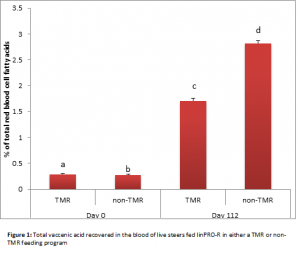February, 2019
The Agriculture and Agri-Food Canada Lacombe Research and Development Centre research feedlot feeding strategies desigened to improve the nutritional value of beef products for consumers.
Advances in nutritional sciences have allowed for a better understanding of how individual fatty acids affect human health. This knowledge has inspired Animal Scientists to focus on improving the fatty acid profile of meat by adjusting animal diets. The Agriculture and Agri-Food Canada Lacombe Research and Development Centre is contributing to progress in this area through their innovative beef research program, and a current focus is on developing linPRO-R feeding strategies to optimize levels of healthful fatty acids in beef.
Increasing healthful fatty acids, such as omega-3s, is of interest due to their many health benefits (i.e. improved cardiovascular health and anti-inflammatory properties). In addition to omega-3s, feeding flaxseed products to cattle can increase levels of other fatty acids, such as rumenic and vaccenic acids, which may have roles in prevention of a number of diseases from cancer and cardiovascular disease to diabetes.
When feeding flaxseed products to cattle, rumen microorganisms can change the structure of polyunsaturated fatty acids through a process known as biohydrogenation. This process includes the production of both rumenic and vaccenic acids as intermediates. Consequently, goals for developing linPRO-R feeding strategies include optimizing levels of rumenic and vaccenic and omega-3 fatty acids leaving the rumen for incorporation into animal tissues.
Previous work conducted by the Lacombe Research and Development Centre feeding cattle total mixed rations containing flaxseed resulted in variable beef fatty acid compositions. An important observation was that when cattle sorted and ate feedstuffs separately, higher levels of healthful fatty acids in beef appeared to be found. This inspired Dr. Mike Dugan and his research team to investigate different feeding strategies designed to optimize beef fatty acid composition. In their current study, they are trying to determine if feeding linPRO-R mixed with hay (TMR) or feeding it before hay (non-TMR) will affect beef fatty acid composition. At the halfway point of the trial, blood fatty acid profiles were measured as an indicator of what might be going on the in the meat. Results showed a 65% increase in blood vaccenic acid when steers were fed linPRO-R before hay (Figure 1). These findings imply that feeding linPRO-R prior to hay might be a good strategy for improving the nutritional value of beef. Based on this information, it becomes clear that the nutritional value of beef is not only affected by what the cattle eat but also how they eat it.

This research is paving the way to developing successful animal feeding strategies that maximize omega-3 fatty acids and other healthful fatty acids available in beef. The preliminary (112 day) results are now in press in the Canadian Journal of Animal Science. Further work is currently underway looking at effects on beef quality, beef composition and what subsequent impacts beef fat may have on human health.
This research is being conducted at the Agriculture and Agri-Food Canada Lacombe Research and Development Centre and was funded by the Alberta Meat and Livestock Agency. O&T Farms Ltd. provided linPRO-R for the trial. For more information on this and other research supported by O&T Farms Ltd., please contact the main office by following this link.






